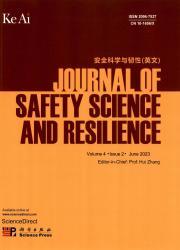社区隔离中心选址的模糊多准则决策框架以增强公共卫生弹性
IF 3.4
Q1 PUBLIC, ENVIRONMENTAL & OCCUPATIONAL HEALTH
引用次数: 0
摘要
传染病爆发需要有效的应急准备战略,包括迅速部署社区隔离中心。然而,为这些设施选择合适的地点是一个复杂的决策问题,涉及多个标准和重大的不确定性,特别是在公众接受和基础设施准备方面。本研究提出了一个模糊多准则决策框架,以支持既提高运营效率又提高社区弹性的选址。该框架不仅将社区复原力定义为从健康冲击中恢复的能力,而且还定义为参与、支持和接受地方公共卫生干预措施的能力。该模型将模糊层次分析法与理想解相似性排序的模糊技术相结合,利用梯形模糊数更好地表达专家判断中的不确定性和社区反馈中的模糊性。一项来自泰国清迈的真实案例研究基于可达性、环境影响、社区同意和应急准备等标准对六个候选地点进行了评估。结果表明,该模型能够支持上下文敏感、透明和有弹性的公共卫生决策。这种方法提供了一种可重复的、计算效率高的决策支持工具,改善了卫生基础设施的选址,从而促进了安全科学。它强调技术和社会层面的一体化,以支持脆弱社区的应急准备和长期复原力。本文章由计算机程序翻译,如有差异,请以英文原文为准。
A fuzzy multi-criteria decision framework for community isolation center site selection to enhance public health resilience
Infectious disease outbreaks require effective emergency preparedness strategies, including the rapid deployment of community isolation centers. However, selecting suitable locations for these facilities is a complex decision-making problem involving multiple criteria and significant uncertainty, especially regarding public acceptance and infrastructure readiness. This research proposes a fuzzy multi-criteria decision-making framework to support location selection that enhances both operational efficiency and community resilience. The framework defines community resilience not only as the ability to recover from health shocks but also as the capacity to engage with, support, and accept local public health interventions. The model integrates the fuzzy analytic hierarchy process and the fuzzy technique for order preference by similarity to the ideal solution using trapezoidal fuzzy numbers to better represent uncertainty in expert judgments and ambiguity in community feedback. A real-world case study from Chiang Mai, Thailand, evaluates six candidate sites based on criteria such as accessibility, environmental impact, community consent, and emergency readiness. The results demonstrate the model’s capacity to support context-sensitive, transparent, and resilient public health decision-making. This approach contributes to safety science by offering a reproducible and computationally efficient decision-support tool that improves the siting of health infrastructure in response to pandemics. It emphasizes the integration of technical and social dimensions to support emergency preparedness and long-term resilience in vulnerable communities.
求助全文
通过发布文献求助,成功后即可免费获取论文全文。
去求助
来源期刊

安全科学与韧性(英文)
Management Science and Operations Research, Safety, Risk, Reliability and Quality, Safety Research
CiteScore
8.70
自引率
0.00%
发文量
0
审稿时长
72 days
 求助内容:
求助内容: 应助结果提醒方式:
应助结果提醒方式:


